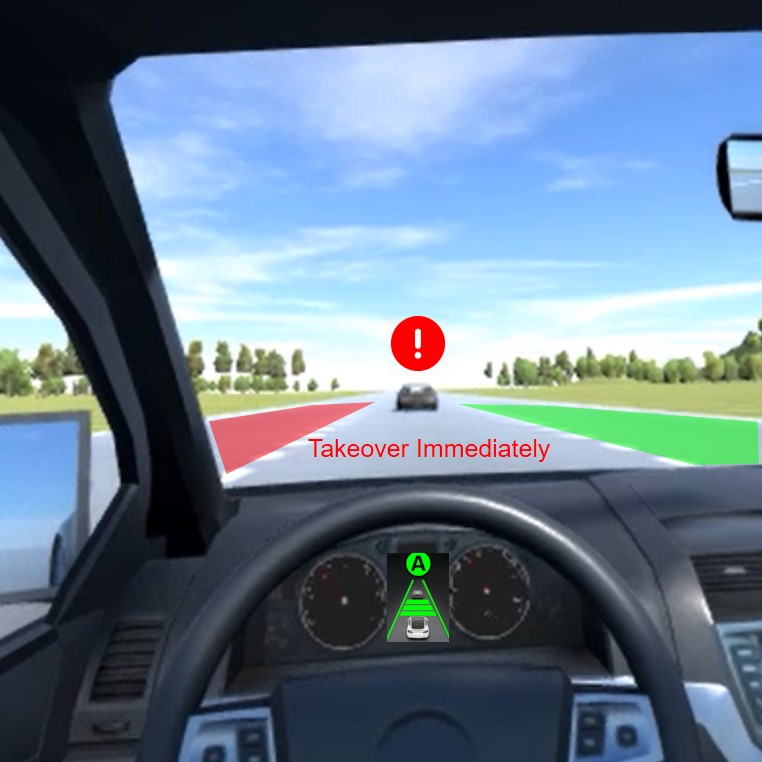
Abstract
The number of automated features in surface vehicles is increasing as new vehicles are released each year. Some features allow drivers to temporarily take their attention off the road to engage in other tasks. However, sometimes it is important for drivers to immediately take control of the vehicle. To take control safely, drivers must understand what is required of them and have the situation awareness (SA) to understand important changes or factors within the environment around them. To achieve this, drivers may be presented with necessary takeover information using a head-up display (HUD), which keeps the driver’s eyes on the road. This study investigated the impact of novel HUDs on driver SA during takeover on highways. Data collection included empirical data for takeover performance metrics, self-reported SA, and participant preferences. To investigate differences between conditions, statistical analyses utilized repeated measure analyses of variance (ANOVAs). The results indicated that HUDs can increase aspects of takeover performance on highways, with participants demonstrating lower response times and higher time-to-collision metrics. There was no significant impact of HUDs on driver SA. Results of this work identified potential use cases and design criteria for new designs of novel HUDs to deliver important information during takeover. |
Project Highlights
- Results of this research indicated support for the use of HUDs to increase takeover performance on highways when using SAE L3 technologies.
- Results of the literature review were submitted, accepted, and presented at the 2020 Human Factors and Ergonomics Society Annual Meeting.
- The project was presented to the industry champion and members of their division during the summer of 2020. Results of the research were well received and guidance for future work was given.
- The work resulted in a contribution for a graduate student’s dissertation and helped inform the second and third contributions. The student successfully defended their dissertation in June 2023
Final Report
EWD & T2 Products
Course Module for a graduate level course entitled “Advanced Vehicle Safety Systems”: This research informed the development of a presentation on rapid prototyping and evaluation of automotive HMIs in virtual environments. This module gives a project overview, specifications of the driving simulator, HMIs, driving scenarios, and how data was extracted from the driving simulator. The goal of this module is to identify what is needed for development of successful driving simulator studies by giving examples of problems faced and how those problems were overcome by researchers. Course Modules are available here.
VR Demonstration to the Industry Champion: Greatbatch, R., Krasner, A., Kim, H., Doerzaph, Z., Llaneras, E. (2019, December 20th). Guiding Driver Responses During Manual Takeovers From Automated Vehicles. General Motors and VTTI.
Webinar Presentation to Industry Champion and Associated Group: Greatbatch, R., Krasner, A., Kim, H., Doerzaph, Z., Llaneras, E. (2020, June 25th). VTTI-00-026: Guiding Driver Responses During Manual Takeovers From Automated Vehicles. General Motors and VTTI.
Greatbach, R. (2023). Augmented Reality Head-Up Displays’ Ability to Increase Driver Situation Awareness During Takeover Scenarios in Driving Automation Systems [Doctoral dissertation, Virginia Tech University].
VTTI 00-026Student Impact: Two students received funding under this project (Richard Greatbach, A PhD student in the Department of Industrial Systems Engineering and Alexander Krasner, a Masters’s student in the Department of Computer Science, both from VT). This file contains a statement by both students as to the impact this project had on their education and workforce development.
Presentations/Publications
Greatbatch, R.L., Kim, H., Doerzaph, Z. (2022). The Effects of Augmented Reality Head-Up Display Graphics on Driver Situation Awareness and Takeover Performance in Driving Automation Systems. Presented at the 1st International Workshop on Extended Reality for Industrial and Occupational Supports (XRIOS) at IEEE VR 2022, Online. DOI: 1109/VRW55335.2022.00116. Presentation available here.
Final Dataset
The final datasets for this project are located in the Safe-D Collection on the VTTI Dataverse; DOI: 10.15787/VTT1/FJYGL1.
Research Investigators (PI*)
Naomi Dunn (VTTI)*
Hyungil Kim (VTTI)
Eddy Llaneras (VTTI)
Zac Doerzaph (VTTI)
Rick Greatbatch (VT-Student)
Alex Krasner (VT-Student)
Project Information
Start Date: 2019-08-10
End Date: 2021-05-01
Status: Complete
Grant Number: 69A3551747115
Total Funding: $349,380
Source Organization: Safe-D National UTC
Project Number: VTTI-00-026
Safe-D Theme Areas
Automated Vehicles
Connected Vehicles
Safe-D Application Areas
Driver Factors and Interfaces
Performance Measures
Planning for Safety
Vehicle Technology
More Information
Sponsor Organization
Office of the Assistant Secretary for Research and Technology
University Transportation Centers Program
Department of Transportation
Washington, DC 20590 United States
Performing Organization
Virginia Polytechnic Institute and State University
Virginia Tech Transportation Institute
3500 Transportation Research Plaza
Blacksburg, Virginia 24061
USA
